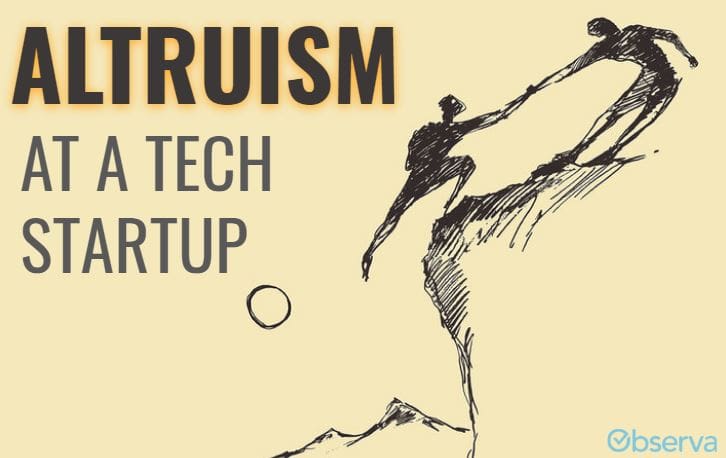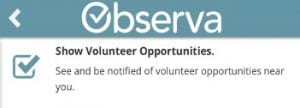by Erik Chelstad, Observa CTO
Remember the classic and corny line that launched a thousand high-school graduation speeches — “Webster’s dictionary defines ‘blah’ as ‘blah blah blah’”? I was really tempted to kick things off with that when talking about altruism, but I’ll avoid it. Altruism, like success, means different things to different people, but at its core, it’s about giving — and to give, you have to have. When you’re at a startup, you don’t have time, and you don’t have money. What you do have is the product that you love and are passionate about. So share your dream! It has value for you, your employees, your investors, and your customers, so there are many others who would benefit from it as well.

Donating cash is easy because it can be used for anything. Donating your product isn’t as simple because you have to find an organization that can use it. Donating cash is also pseudo-anonymous (it can be hard to identify donors), whereas donating the use of your product may result in a public linking. Although this might be great, it could also be risky if the organization you’re donating to is controversial or is caught up in a scandal. Imagine if you were a blockchain startup that helped track the use of expenses, so you donated services to the Red Cross, and then the part you weren’t helping with lost $500 million in Haiti. Mere association could get your company negative press very quickly. Just like when you donate cash, investigate who you’re working with using tools like Charity Navigator.
Boundaries are important.
I know you’ve heard this in other contexts, but it’s critical here too. Although your product is designed to be infinitely scalable and easy to use, it’s probably not quite there just yet. This means that each product “donation” you make is going to cost some amount of your time, your technical resources, and other members of your team. Like I said at the top, those are things you don’t have to give, so make sure you set limits on how much you burn helping to onboard, configure, tweak, integrate, and so on with your nonprofit partners. Value your system in dollars just like you would for a sale and set a limit. Be up-front about it so that no one is shocked or disappointed. You want to make sure you get to the point where you’re providing value, not a half-baked implementation. At the beginning stages, you may be short on customers, so remember this is one more opportunity to make sure your onboarding, integration, and implementation are the best.
In his book Onward, Starbuck’s ex-CEO, Howard Schultz (or someone else working at the coffee powerhouse), coined the term “brand sparks” for marketing that is “linked to cultural or humanitarian issues and devoid of a self-serving sales pitch.” It’s debatable whether this is even possible for a business, but I think the point is worth considering. You can always feel good about your altruistic acts, but you can choose to be completely anonymous and still receive the other benefits. At the same time, you can choose to be very public about what you’re doing to receive some free marketing and PR. In the seminal manual for getting cheap attention, Guerrilla Marketing by Jay Levinson, there’s an entire section on how to give away logoed food to hungry on-camera rescue workers.
When I used to play in a band, we’d book a lot of shows that we knew would have a low turnout, so we’d just turn them into a charity event, charging winter jackets or cans of food for admission. Not only did we get an audience, new fans, and free publicity, but we, and the owner of the dive bar we were playing in, could feel good in our hearts for helping someone else. There’s not really a right or wrong; it’s about your ethics and motivations, but again, any way you choose, you win if you make a clear choice when entering the relationship.

Corporate Social Responsibility (CSR) is an important topic today.
I didn’t want to leave this out, but I did leave it until the end because CSR doesn’t affect your business as directly as you might think. Studies show mixed results, but purchase choices are only positively affected when your CSR program directly affects a customer’s interaction with your brand; an example is using organic ingredients to highlight benefits to both customers and the planet. It can mean a lot to the biggest generation of consumers (millennials), but usually on an individual and employment basis. The old adage goes, “things end the way they begin,” so setting yourself up for CSR in the infancy (or even young adulthood) of your company is a wise investment. Right away you can use it as a recruiting tool and possibly even get a more valuable brand or topic associated with your company than you might without an altruistic approach.
I’d be remiss not to plug my company, Observa, a bit, so I’ll just say that we built altruistic capabilities into our system from the beginning. We let our observers choose to see altruistic opportunities or not, and then they are free to willingly participate in data collection for the projects and nonprofits we have partnered with. By letting observers choose to donate their time and effort, we eliminate our biggest cash expense. Aside from the warm fuzzies, we also get some good will and increase general awareness of what we do among our observer community.
Finally, we use our work with our nonprofit partners to load our system and stretch our reporting capabilities. We set boundaries by limiting participation to verified nonprofit organizations and capping the amount of data we collect. While we don’t expect our altruistic efforts to directly lead to gains in new revenue from paying customers, we do look forward to this work exposing our brand and our capabilities to a wider audience than the one we would otherwise reach. We like it, feel good about it, benefit directly and indirectly, and we want to listen to you if you’re interested in collecting real world-data for your non-profit.
Takeaways
- Don’t give away what you don’t have: cash and unstructured time.
- Unlike donating cash, it takes effort to give away your product.
- Be careful whom you donate to because it could result in negative publicity.
- Set limits up front and stick to them.
- Treat your nonprofit partner like a customer so that you learn and grow.
- Decide on what you want to get out of your donation.
- CSR isn’t just for the big kids.

